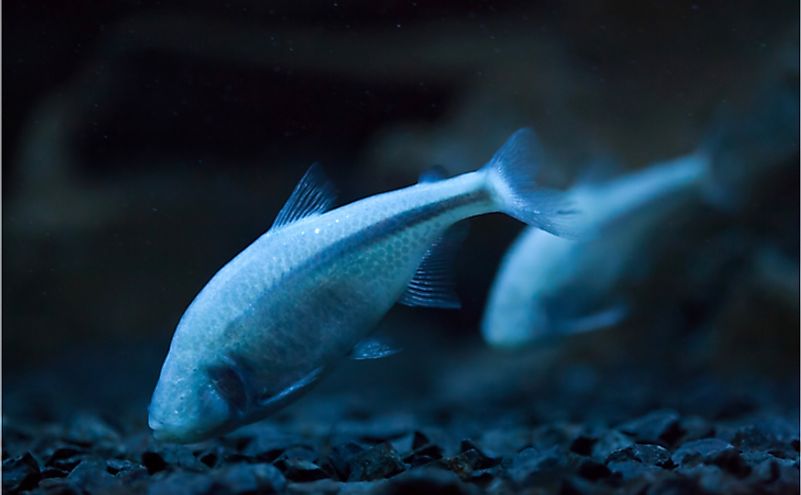What Are The Adaptations In Cave-dwelling Animals?

Cave-dwelling animals have developed special characteristics that have adapted them to the dark environment in the caves. These subterranean animals are grouped into two broad categories based on their life history, and they are troglofauna and stygofauna.
Troglofauna
Troglofauna refers to terrestrial or air-breathing animals living underground in the caves and other spaces filled with air below the ground. Troglofauna are found in caves and other caverns that have been developed by weathering or fracture of any type of rock such as limestone, pisolite, basalt, dolomite, calcrete, granite, sandstone, and colluvium among others. Some of the troglofauna include species of arachnids and spiders, beetles, millipedes, cockroaches, crickets, and several other invertebrates. Some of these troglofauna are particularly adapted to life in underground habitats in complete darkness, and they are referred to as troglobites.
Stygofauna
Stygofauna refers to aquatic animals that live in underground water, and they inhabit different types of underground water habitats. Most of the stygofauna are mainly invertebrates of crustacean species, but there are also snails, worms, water mites, fish, and diving beetles. These are also animals that have developed special adaptations enabling them to survive in complete darkness. These aquatic stygofauna that live permanently in the dark are known as stygobites.
Loss Of sight
Deep caves are characterized by permanent darkness. Animals that have colonized such habitats have unique adaptations. Caves have limited availability of food because of the absence of local photosynthesis. Food availability in the caves is unscheduled, episodic, or seasonal. With food being scarce in such an ecosystem, the cave-dwellers are forced to save and conserve energy. The absence of eyes is a significant boost in saving energy by the cave dwellers. According to scientists from Lund University in Sweden, there is energy cost associated with eyes, and this was established through the calculation of oxygen consumed on eyes and other vision-related regions of the brain. The scientists discovered that the cost of energy for sight in a non-cave dwelling fish was approximately 15% less if they were blind. Vision is costly as a result of the energy requirement of photoreceptive neurons and cells. Typically, underground caves are poorly supplied with oxygen and food, and therefore, the animals with reduced visual perception are better adapted to such a harsh environment. Permanent cave-dwelling fish such as the Astyanax mexicanus also have considerably reduced midbrain, which is the region that is responsible for vision. Since animals require food energy for eye maintenance, troglobites can survive for long with less food compared to animals with eyes. Eyes are also prone to injury, and therefore, these animals have developed this unique trait to diminish such injuries by losing their eyes. Another theory, which has been used to explain the loss of sight on the cave dwellers, is the expensive tissue hypothesis, although it has not been tested scientifically.
Loss of body pigmentation
The troglobites have also developed a unique adaptation to the dark caves by losing their body pigmentation, and most of these animals appear like albinos. This unique adaptation has led these animals to degenerate organs, which are not needed while enhancing those organs that help them to survive. In the dark caves, the animals do not need pigmentation that helps their counterparts to escape predators or to ensnare prey. Similarly, these animals do not need pigmentation to protect their bodies from sunlight since the habitat is perpetually dark.
Enhanced sensory mechanisms
Whatever the troglobites have lost, they have more than compensated for by the development of other organs that enhance their survival. Some of the features which have evolved for the troglobites to enhance their survival in completely dark habitats include the changes in the sensory organs and their brain. In some animals such as cavefish, they have an enhanced olfactory sensitivity, which helps them to smell better, and understand their environment while some can detect vibrations and pressure of water in their habitats. These types of fish have a lateral line that detects vibrations, which is an adaptation unique to the aquatic vertebrates that help them in movement. With this unique adaptation, the animals have an enhanced ability to conserve energy while at the same time increasing their ability to store metabolic products because of food scarcity.
Other morphological adaptations
Some cave-dwelling animals have also developed unique and bizarre adaptations to cope with the harsh environment. Some such features include strange mouthparts, legs which have been turned into silk secreting organs, and nozzles that can squirt defensive chemicals.
Source of food for the cave dwellers
Since caves lack sunlight and therefore have no plants growing in them, these unique ecosystems have a different source of energy. Leaves that are washed or brought in by other organisms that wander out of the caves often form the base of the cave ecosystem food chain. The washed litter becomes the food for the fungi and bacteria which grow on these materials, and millipedes and other small bugs feed on fungi and bacteria, and other larger animals feed on these tiny animals, and this creates a vibrant ecosystem of interdependence. The droppings of animals also feed the bacteria and fungi that form the base of the food chain in the cave system.











